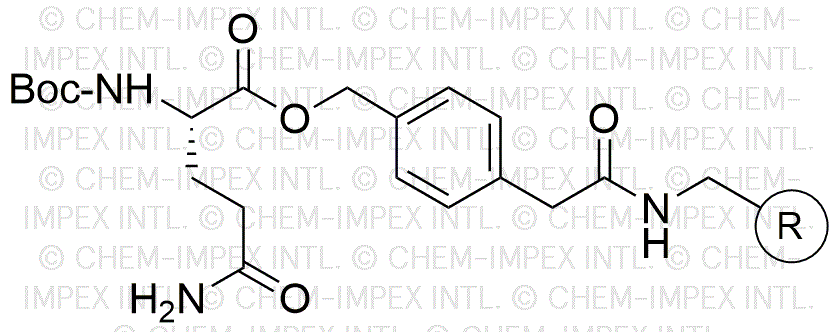Na-Boc-L-glutamine 4-oxymethylphenylacetamidomethyl is widely utilized in research focused on:
- Peptide Synthesis: This compound serves as a key building block in the synthesis of peptides, which are essential in drug development and biological research.
- Drug Development: Its unique structure allows for modifications that can enhance the efficacy of pharmaceutical compounds, making it valuable in medicinal chemistry.
- Bioconjugation: The compound is used in bioconjugation processes to attach drugs or imaging agents to biomolecules, improving targeted delivery in therapeutic applications.
- Research on Protein Interactions: It aids in studying protein-ligand interactions, which is crucial for understanding biological processes and disease mechanisms.
- Development of Diagnostic Tools: This chemical can be utilized in the creation of diagnostic assays, contributing to advancements in medical testing and disease detection.
General Information
Properties
Safety and Regulations
Applications
Na-Boc-L-glutamine 4-oxymethylphenylacetamidomethyl is widely utilized in research focused on:
- Peptide Synthesis: This compound serves as a key building block in the synthesis of peptides, which are essential in drug development and biological research.
- Drug Development: Its unique structure allows for modifications that can enhance the efficacy of pharmaceutical compounds, making it valuable in medicinal chemistry.
- Bioconjugation: The compound is used in bioconjugation processes to attach drugs or imaging agents to biomolecules, improving targeted delivery in therapeutic applications.
- Research on Protein Interactions: It aids in studying protein-ligand interactions, which is crucial for understanding biological processes and disease mechanisms.
- Development of Diagnostic Tools: This chemical can be utilized in the creation of diagnostic assays, contributing to advancements in medical testing and disease detection.
Documents
Safety Data Sheets (SDS)
The SDS provides comprehensive safety information on handling, storage, and disposal of the product.
Product Specification (PS)
The PS provides a comprehensive breakdown of the product’s properties, including chemical composition, physical state, purity, and storage requirements. It also details acceptable quality ranges and the product's intended applications.
Certificates of Analysis (COA)
Search for Certificates of Analysis (COA) by entering the products Lot Number. Lot and Batch Numbers can be found on a product’s label following the words ‘Lot’ or ‘Batch’.
*Catalog Number
*Lot Number
Certificates Of Origin (COO)
This COO confirms the country where the product was manufactured, and also details the materials and components used in it and whether it is derived from natural, synthetic, or other specific sources. This certificate may be required for customs, trade, and regulatory compliance.
*Catalog Number
*Lot Number
Safety Data Sheets (SDS)
The SDS provides comprehensive safety information on handling, storage, and disposal of the product.
DownloadProduct Specification (PS)
The PS provides a comprehensive breakdown of the product’s properties, including chemical composition, physical state, purity, and storage requirements. It also details acceptable quality ranges and the product's intended applications.
DownloadCertificates of Analysis (COA)
Search for Certificates of Analysis (COA) by entering the products Lot Number. Lot and Batch Numbers can be found on a product’s label following the words ‘Lot’ or ‘Batch’.
*Catalog Number
*Lot Number
Certificates Of Origin (COO)
This COO confirms the country where the product was manufactured, and also details the materials and components used in it and whether it is derived from natural, synthetic, or other specific sources. This certificate may be required for customs, trade, and regulatory compliance.

